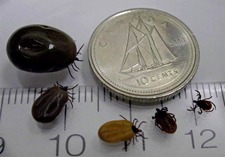Spot the symptoms of Lyme disease and protect yourself from ticks

With families in the midst of summer vacations and many attempting to make the most of the remaining outdoor season, we want to remind everyone to take the proper precautions to avoid tick bites that can cause Lyme disease.

An increase in tick populations is making cases of Lyme disease more common – in Ontario, it is transmitted through an infected blacklegged tick. The risk for infection is highest in areas where the tick species has established populations, including parts of southern and eastern Ontario.
“We recommend that all individuals take protective measures. If you or someone you know suspects Lyme disease, it is important to consult your doctor immediately,” says Aurora Wilson, infection prevention and control manager at Providence Healthcare. “Early detection and removal is important.”
What are symptoms of Lyme disease?
Typical symptoms of Lyme disease include fever, headache, fatigue, and muscle and joint aches. A characteristic skin rash called erythema migrans (EM) occurs in about 70-80 percent of infected persons. EM begins within 3 to 30 days at the site of the tick bite. The average appearance of this rash occurs around seven days after the bite, and it can grow to around 12 inches or more. It may look like a “bullseye” and could feel warm to touch, but is rarely itchy or painful

.
In a small percentage of cases, symptoms can last for more than six months. This is sometimes referred to as chronic Lyme disease. Some patients may not experience symptoms for weeks or months after the initial bite. Symptoms of ‘late Lyme disease’ include arthritis, and pain and swelling of joints, especially the knees.
Late Lyme disease signs and symptoms include those affecting the nervous system. Other rare symptoms include irregularities of heart rhythm and problems with memory, concentration, and sleep disturbances. Lyme disease is diagnosed based on symptoms, as well as the potential for exposure to infected ticks.
How do you prevent Lyme disease?
The best method of prevention is to prevent tick bites altogether. For those exposed to tick bites, early treatment is key. Persons treated with appropriate antibiotics during the early stages of Lyme disease usually recover rapidly and completely. The risk of exposure to ticks is greatest in the woods and in the space between lawns and the edge of the woods. Ticks can also hitchhike to your lawn and into your house via your pet.
You can decrease your risk of being bitten by a tick by following a few precautions including:
- Avoid tick-infested areas, especially during the summer and fall months.
- When in a tick-infested area, walk in the center of trails and avoid contact with overgrown grass, brush, and leaf litter at trail edges.
- Use EPA-approved insect repellent that contains a 20 percent concentration of DEET on clothes and on exposed skin.
- Always check for ticks after being outdoors, even after being in your own yard.
- Bathe or shower after coming indoors to wash off and more easily find ticks that are crawling on your body.
What do blacklegged ticks look like?
Blacklegged ticks are small and hard to see. They attach themselves to humans and animals and feed on their blood. They can range in size depending on how long they have been feeding.

How do you safely remove a tick?
According to Government Canada, ticks attach themselves to the skin. Most humans are infected through the bite of immature ticks called nymphs. Adult ticks can also transmit Lyme disease bacteria. Their bite is usually painless, so you may not know you’ve been bitten.
If you notice a tick has attached itself, remove it as soon as possible. Removing ticks within 24 to 36 hours usually prevents infection. If you find a tick attached to your body, follow these steps to properly remove a tick.
